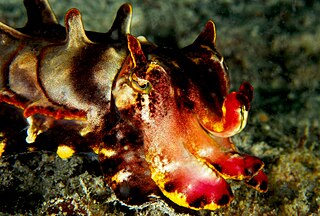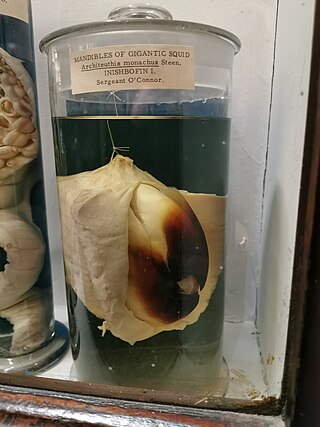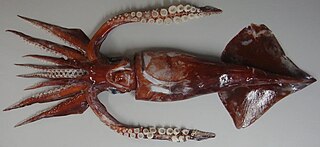
An octopus is a soft-bodied, eight-limbed mollusc of the order Octopoda. The order consists of some 300 species and is grouped within the class Cephalopoda with squids, cuttlefish, and nautiloids. Like other cephalopods, an octopus is bilaterally symmetric with two eyes and a beaked mouth at the center point of the eight limbs. The soft body can radically alter its shape, enabling octopuses to squeeze through small gaps. They trail their eight appendages behind them as they swim. The siphon is used both for respiration and for locomotion, by expelling a jet of water. Octopuses have a complex nervous system and excellent sight, and are among the most intelligent and behaviourally diverse of all invertebrates.

A squid is a mollusc with an elongated soft body, large eyes, eight arms, and two tentacles in the superorder Decapodiformes, though many other molluscs within the broader Neocoleoidea are also called squid despite not strictly fitting these criteria. Like all other cephalopods, squid have a distinct head, bilateral symmetry, and a mantle. They are mainly soft-bodied, like octopuses, but have a small internal skeleton in the form of a rod-like gladius or pen, made of chitin.

Vitreledonella richardi, also known as the glass octopus, is an incirrate octopus. It is in the genus Vitreledonella and of the family Amphitretidae.

Jasus edwardsii, the southern rock lobster, red rock lobster, or spiny rock lobster, is a species of spiny lobster found throughout coastal waters of southern Australia and New Zealand including the Chatham Islands. It is commonly called crayfish in Australia and New Zealand and kōura in Māori. They resemble lobsters, but lack the large characteristic pincers on the first pair of walking legs.

Euprymna tasmanica, also known as the southern dumpling squid or southern bobtail squid, is a bobtail squid that lives in the shallow temperate coastal waters of southern Australia's continental shelf. It lives for between 5 and 8 months and the adults can grow up to 6 or 7 cm long with a mantle length of 3 to 4 cm. They are found in seagrass beds or areas with soft silty or muddy bottoms from Brisbane on the east coast to Shark Bay on the west, as well as around Tasmania. Southern dumpling squid are nocturnal and during the day hide in sand or mud covered in a mucus-lined coat of sediment. If disturbed acid glans can quickly remove this coat as an additional decoy to ink squirting.

Doryteuthis opalescens, the opalescent inshore squid or market squid, is a small squid in the family Loliginidae. It is a myopsid squid, which is the near shore group and that means that they have corneas over their eyes. The species lives in the eastern Pacific Ocean from Mexico's Baja California peninsula to Alaska, United States, and as an inshore squid it can be found with a range of 200 miles (320 km) off the coast.

The giant Pacific octopus, also known as the North Pacific giant octopus, is a large marine cephalopod belonging to the genus Enteroctopus and Enteroctopodidae family. Its spatial distribution encompasses much of the coastal North Pacific, from the Mexican state of Baja California, north along the United States' West Coast, and British Columbia, Canada; across the northern Pacific to the Russian Far East, south to the East China Sea, the Yellow Sea, the Sea of Japan, Japan's Pacific east coast, and around the Korean Peninsula. It can be found from the intertidal zone down to 2,000 m (6,600 ft), and is best-adapted to colder, oxygen- and nutrient-rich waters. It is one of the largest octopus species on earth and can often be found in aquariums and research facilities in addition to the ocean. E. dofleini play an important role in maintaining the health and biodiversity of deep sea ecosystems, cognitive research, and the fishing industry.

Metasepia pfefferi, also known as the flamboyant cuttlefish, is a species of cuttlefish occurring in tropical Indo-Pacific waters off northern Australia, southern New Guinea, as well as numerous islands of the Philippines, Indonesia and Malaysia.

Nototodarus sloanii is a species of squid commonly known as the New Zealand arrow squid or Wellington flying squid. It is also known by its Māori name of wheketere. It is a favoured prey species of a number of marine mammals and diving birds. It is an important food source for the New Zealand fur seal and two endangered species: the New Zealand sea lion and the yellow-eyed penguin. N. sloanii is sought by trawler fishermen for human consumption; New Zealand sea lions are frequently caught in trawl nets and drowned when feeding on N. sloanii.

Vulcanoctopus hydrothermalis, also known as the vent octopus, is a small benthic octopus endemic to hydrothermal vents. Notably, It is the only known species of the genus Vulcanoctopus. This vent octopus is endemic to the hydrothermal vent habitat that is located in the East Pacific Rise.

All extant cephalopods have a two-part beak, or rostrum, situated in the buccal mass and surrounded by the muscular head appendages. The dorsal (upper) mandible fits into the ventral (lower) mandible and together they function in a scissor-like fashion. The beak may also be referred to as the mandibles or jaws. These beaks are different from bird beaks because it crushes bone while most birds don't.

Illex coindetii, commonly known as the southern shortfin squid or broadtail shortfin squid, is a species of neritic squids in the family Ommastrephidae. They are found in the Mediterranean Sea and on both sides of the north Atlantic Ocean.
Eledone massyae, the combed octopus, is a small benthic octopus found off the Atlantic coasts of southern South America, particularly Argentina and southern Brazil.
Octopus chierchiae is commonly known as the lesser Pacific striped octopus or pygmy zebra octopus. It has been proposed as a model organism for cephalopod research as it is one of the few octopus species with the ability to lay multiple egg clutches (iteroparity), compared to most octopus species that are semelparous and die after one reproductive event. This makes Octopus chierchiae a candidate for sustainable and multigenerational laboratory research.

Octopus tetricus, the gloomy octopus or the common Sydney octopus, is a species of octopus from the subtropical waters of eastern Australia and New Zealand. O.tetricus belongs to the Octopus vulgaris species group and is a commercially prized species. All species within the O. vulgaris group are similar in morphology. The English translation of O. tetricus (Latin) is 'the gloomy octopus'.

Pinnoctopus cordiformis is a species of octopus found around the coasts of New Zealand. It is one of the most common species of octopus in the country.

The Antarctic flying squid is a species of squid from the subfamily Todarodinae of the family Ommastrephidae, a family of pelagic squid from the order Oegopsida. It has a circumglobal distribution in the seas around the lower latitudes of the Southern Ocean.

Wunderpus photogenicus, the wunderpus octopus, is a small-bodied species of octopus with distinct white and rusty brown coloration. 'Wunderpus' from German “wunder” meaning ‘marvel or wonder’.

Octopus bimaculatus, commonly referred to as Verill's two-spot octopus, is a similar species to the Octopus bimaculoides, a species it is often mistaken for. The two can be distinguished by the difference in the blue and black chain-like pattern of the ocelli. O. bimaculatus hunt and feed on a diverse number of benthic organisms that also reside off the coast of Southern California. Once the octopus reaches sexual maturity, it shortly dies after mating, which is approximately 12–18 months after hatching. Embryonic development tends to be rapid due to this short lifespan of these organisms.

Octopus insularis is a species of octopus described in 2008 from individuals found off the coast of Brazil, with a potentially much larger range.


















